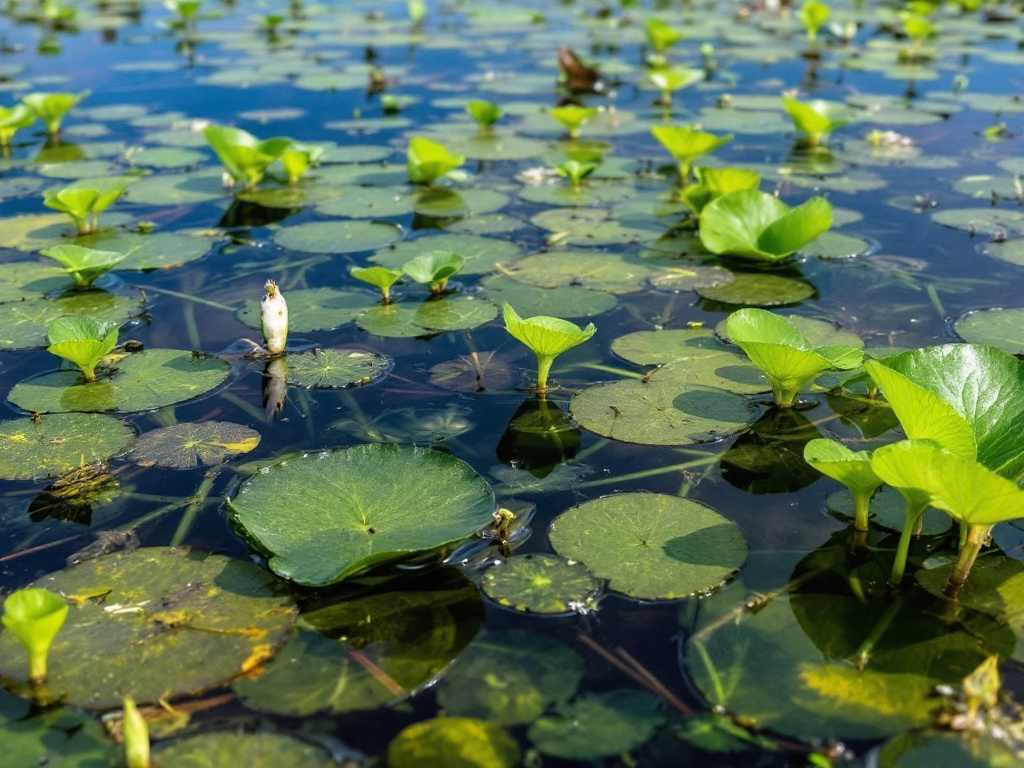Image generated by flux-ai.io & content generated by ChatGPT Version 4o-mini
New Herbicide Application Technique Could Benefit Washington County’s Lakes and Waterways
As residents of Washington County know well, our beautiful lakes and rivers are vital for recreation, wildlife, and even agriculture. However, invasive aquatic weeds, like hydrilla, can threaten these ecosystems, making effective control methods essential. A recent study from the University of Florida highlights a new technique for applying herbicides that could change how we manage these pesky plants, potentially leading to healthier waterways for our community.
Traditionally, herbicides were applied throughout the entire water column of lakes, which can be wasteful and less effective. This is especially true in water bodies that are deeper than 7 feet, where a significant portion of the herbicide may never reach the invasive plants sitting on the bottom. The new method discussed in the study involves using a “bottom acre-foot” technique with weighted hoses to deliver herbicides directly to the areas where the weeds thrive—in the lower parts of the water column.
Targeted Approach to Weed Control
The study emphasizes that many aquatic weeds, like hydrilla, grow primarily in the lower layers of the water. By using weighted hoses that sink to the bottom, applicators can apply herbicides where they are needed most, rather than dispersing them throughout the entire lake. This method not only reduces the amount of herbicide needed but also minimizes the environmental impact by limiting exposure to non-target areas. This targeted approach aligns with best management practices by focusing on precise application rather than broad-spectrum methods.
For residents who enjoy fishing, boating, or even just swimming in our local lakes, this targeted approach means clearer water and healthier habitats. Less weed growth can lead to more enjoyable recreational activities, and it helps protect the diverse wildlife that calls our lakes home.
How the System Works
The weighted hoses used in this technique are designed to sink and stay submerged, ensuring that the herbicide is delivered directly to the targeted weed beds. The study describes how these hoses are attached to a pump on a boat, allowing for controlled application as the boat moves slowly across the water. This method may take a bit more time than traditional spraying, but its effectiveness could mean longer-lasting results against invasive plants while adhering to the principle of selective application.
In Washington County, where many families rely on our natural resources for recreation and even livelihoods—like fishing or managing local farms—this new herbicide application method could have significant benefits. With our community’s strong interest in agriculture and land use, employing more efficient weed control techniques can help preserve the balance between productive land and healthy water ecosystems.
Potential Impact on Local Waterways
As Washington County continues to grow, managing our natural resources becomes increasingly important. The findings from this study suggest that adopting the bottom acre-foot method could lead to healthier aquatic environments, supporting local wildlife and recreational activities. This could be especially beneficial during the hot summer months, when water temperature stratification can make it hard for surface-applied herbicides to reach their intended targets.
As the local community considers the future of our lakes and rivers, it’s essential to explore innovative methods like this one. For farmers, boaters, and families in Washington County, better weed management means cleaner waters, more enjoyable outdoor experiences, and a healthier ecosystem overall. It is vital that any herbicide application in these areas follows label instructions to ensure safety and environmental protection.
In conclusion, the new research from the University of Florida presents an exciting opportunity for Washington County residents to enhance our approach to aquatic weed control. By adopting more targeted herbicide application methods and following best practices outlined by EDIS/IFAS, we can protect our precious waterways for generations to come while enjoying the natural beauty that surrounds us.
References
SS-AGR-352/AG360: Constructing Weighted Trailing Hoses for Submersed Aquatic Herbicide Applications. (n.d.). Ask IFAS – Powered by EDIS. https://edis.ifas.ufl.edu/publication/AG360

